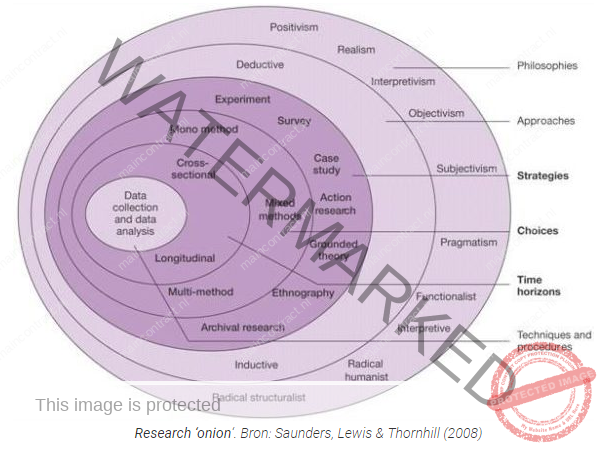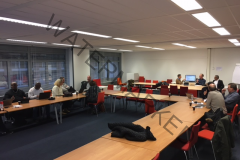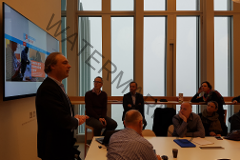See also: “The Line of Sight: Deepening The Subject”
The research is focused on the role of Maintenance Management as one of the four fundamental basis of Assetmanagement as defined in the NEN-ISO 55000. The reason is that the ISO 55000 Maintenance management regarded as one of the four fundamental pillars of Assetmanagement. Despite the fact that the standard defines a Asset in such a way that it could be anything, it gives no insight into the structures in which Assets are composed. The research aims to provide insight into this through from the inheritance the three types of element structures (Civil, Buiding and Industrial Process) adding to the paradigm used by the standard and connecting the policy to the smallest Asset component. This linkage is named “The Line Of Sight” and is based on the analogy with the ” Research Onion “. The following considering describes (shortened) this insight so that the degree of influence of failure by the smallest Asset Component definable and/or quantified and is part of a number of related topics. Derived of this consideration is the SAMP/AMP, the defenition of the concept Maincontracting and other related topics and objectives of the research.
- Draft Version: 17 June 2014
- Updated December 3, 2015
- Updated February 8, 2017
- Updated 23 September 2017
Pagina Inhoud
![]()
Assetmanagement, we could speak of an “Assetmanagement Onion”. By peeling the Assetmanagement, layer by layer, we finally arrive at the smallest part of the asset (component) which ideally does exactly what the organization’s policy or management had envisaged during the lifetime of the component. In fact, it can only when these two are associated with each other during the lifetime of the smallest element. As long as the company policy or objective, and the smallest component but there can be interconnected “moved along” in the internal and external context of the Asset. This link is in English “Line Of Sight”, however, said in the study, “Linking policy to Maintenance Activity.” The policy prepared by linking the management of the component ** will do exactly the component for life from what is expected. In that paradigm are failures not what actually should be the way of thinking.
![]()
* Research ‘onion’. Source: Saunders, Lewis and Thornhill (2008)
** Component smallest particle of an asset in accordance with BS 2767 2013 version.
When Assetmanagement
Once an organization is responsibel for Assets withing a Portfolio the organization is engaged in assetmanagement with the objective create value. Value comes in many forms and can be anything; financial, material, service, estetical etc etc. It may be that achieving uptime for example, a data center of the organization is the most important, or producing the most liters of beer, or just the most liters of beer at the lowest possible costs and still achieve the uptime at the lowest energy consumption. But also a pleasant stay, enjoying a safe working environment, the ins tooth like ruins or circular realizing Assets is value creation. It is, thus, to create Assets their value to the organization and its stakeholders. These does not matter what it is an asset. As an asset represents a value can be anything. An asset is a thing, or an entity that has a potential value or actual value. Abstract shapes as knowledge, people, skills, competences … but also buildings, installations in these buildings are also valeu.
Bron Youtube
Bron Youtube
Bron Youtube
Technical Condition related to Lifecycle’s of Assets
1. Paradigma, Conceptual model and theoretical framework
Various institutes defining and formulating views and visually displaying the assetmanagement landscape and content. Most well known are the Institute Of Asset Management (IAM) and the Global Forum On Maintenance & Asset Management ( GFMAM ) which works closely with the European Federation of National Maintenance Societies ( EFMNS ). The Institute of Asset Management (IAM), for example, defines the Asset Management landscape in a conceptual model for the purpose of describing the whole of Asset Management framework. The landscape is divided into six topics that run through 39 processes. The first edition of this landscape was published in Asset Management – An Anatomy November 2011, the second edition was published in March 2014 and the third edition was published in December 2015 (Institute of Asset Management, 2015).



The research sets the NEN-ISO 55000 as a theoretical framework and demarcates responsibility in the situation that the Technical Management and Maintenance based on a system boundary. This system boundary demarcates where the property begins or where the responsibility starts. The research consider the inheritance as the system boundary to include all types of componetens and elementstructures of the three basic element structures of Civil, Building and Industrial components.
An abstract example is shown in Figure 1 and considered from the system boundary “see” we two phenomena, namely: The Asset and his second of four pillars “Reconciliation” in which the Technical Management & Maintenance in operating under. In the figure this is represented by placing “Alignment” within the asset management so that Alignment is a part of the Asset Management. In this approach Aligneme becomes an integral part of the Asset Management moves along with the circumstances,
This approach implies that there is a connection between the framework (Stretegic AssetManagementPlan and AssetmanagementPlan) which is imposed on the asset management and the smallest part. This connection is represented in the figure by an line and two yellow points that, respectively, the purposes of the asset management and represent the smallest part. This link is “The Line of Sight” or as part of the research “Linking Policy to Maintenance Activity.” The intersection such as that shown in Figure 1, as well as the actual separation between the Asset Management and Technical Management and Maintenance where these are defined as:
- The Asset Management: coordinated all activities of an organization to realize value from Assets.
- The Technical Management & Maintenance: Combination of all technical, administrative and managerial actions during the life cycle of an item intended to preserve or restore in a state where it can perform its required function.
The intersection demarcates the framework the Technical Management and Maintenance has to comply. It specifies based on the variables for example what the risks are if componeten or elements failing , what competencies are required by maintenance employees, what level of service should deliverd or how to deal with the lifetime of elements.
1.1 Evaluating Variables
Where the Instutute of AssetManagement the thirty-nine subjects spread over in six “subject-groups” teh research have a different pomit of vieuw. The research regarded as any variable affects the function and / or performance of the smallest Asset Component. As shown in Figure 1 are located at the intersection of the Asset Management and Technical Management and Maintenance of the variables that influence both within the Asset Management and / or the smallest part of the asset. These variables are represented as red spheres on the intersection (system boundary) between Asset Management and Technical Management and Maintenance. The red spheres are the Evaluating Variables and are stand-alone variables and their impact on the smallest part of the asset are either prerequisite check that smallest part. These may be variables like risk, asset management plan or competence and are defined in the NEN-ISO 55000. By placing all the variables in the intersection line there is a frame work of each variable that influens the function or perfomance of the component.
Table 1 shows which variables are and are located at the interface between the Asset Management and Technical Management and Maintenance. These 39 (thirtynine) variables that affect the smallest part of the asset.
2. Analogy : The Research Union

Figure 1 represent in an abstract view the Asset Management and Technical Management & Maintenance. Figure 1 shows the subjects Asset Management and Technical Management and Maintenance appears. In this case, the asset management appears which includes the Technical Management and Maintenance and are therefore inextricably linked in this view. To each subject can be added to a subject again, so that there are several “layers” emerge from which the framework is built up.
Such displays have an anology with the “Research Union” of Sounders, Lewis and Thornhill *. Based on the different layers of the research union science is gained to get insight into the underlying issues that lie at the basis of this methodological choices. The research interpertates the research onion and the way in which the NEN-ISO 55000 explains the relationships between terms, as an analogy, and uses this as a starting point in order to add the various layers to the subjects from which the asset management is built up. The aim is to “peel” the Asset to the smallest component to define as different layers and achieve a conceptual model.
* Sounders, Lewis & Thornhill 2003, Methods of research p.86
2.1 The Assetmanagement layers
The NEN-ISO 55000 denotes the hand of terms and definitions, the relationship between the different subjects. The NEN-ISO 55000 does this have been recorded on the basis of a framework in which different “layers”.
An example of this is Figure 3 of the standard in which four threads are interpreted that have a relation to each other. It is :
- The management of the organization
- asset management
- asset Management System
- Asset Portfolio.
This approach has an analogy, however, the standard provides the wetenschapsui out three major components that indicate the different layers. These are :
- Visualization of linking policy to Maintenance Activity
- The structure of the asset portfolio
- The smallest part of an Asset Portfolio
3. Connecting “policy of maintenance activity”
The link “Policy on Service Activity”, also known as the Line of Sight is an important part of the Asset. The coupling represents that the smallest part its functional performance in the extension of the policy provides delivers its function and performance. Conscious is spoken of here about function and performance.
Is meant that the smallest part of the Asset carries out its function, which may be, for example, ensuring that water flows, cooling takes place, heat is transferred, or otherwise. In performance it is meant that the component in addition to its function, this is also within a specified standard to take place, for example, with an uptime of 360 days a year, or a quality range of 5% depending on whether the delivered product.
It is envisaged that an organization wwordt successful and remains in the objectives. Think of making a profit, producing products of a certain quality or to achieve a certain level aesthetics.
3.1 Connecting variables to components
Achieving objectives or success in achieving organizational objectives or achieving policy. This can only take place if components (elements and components) provide their functions and their performance as intended. That means that the variables that affect it should be marked or create the conditions to achieve these goals. The figure below represents this situation and give in three steps how the smaller part is attached to the policy.
Figuur 4 : Klik voor vergroting
3.2 Deepning the Assetportfolio, Asset and Assetype
In the previous section explained how the policy is linked to the smallest part of the asset. This abstract representation are only shown two topics that play, namely the Asset Management which provides a framework to which it must comply Maintenance Management and the Maintenance Management which has to ensure that the part of the asset produces its function and performance.
This abstract representation can be further divided into layers. Each layer includes an environment in which the smallest part is located and where the policy through the variables establishes the framework and / or influences. In the following view (Figure 5) are the Asset Management and Maintenance Management displayed on a number of levels containing the coupling of the policy to the smaller part and the variables.
Figuur 5 : Klik voor vergroting
Figure 1: Figure 5.1 shows a plurality of layers from which the asset management is built up with two yellow bullits indicated therein, namely: the policy framework, and as a starting point for all the targets and the smallest part of the Asset. The figure shows eight layers in how the organization is built around the portfolio and the manner in which the portfolio is built up.
Figure 2: Figure 5.2 shows as in Figure 3.1 illustrate the correlation between the smallest part, however, the policy and now with clutch and the variables that lie at the interface between the organization and the portfolio which must be maintained.
Figure 3: In Figure 5.3, all variables are associated policies to the smallest component. This view can be traced to different variables affect the smallest part through the various layers of the Asset Management of Assets.
4. Influence and role components towards policy
In Figures 4 and 5 there is shown how the policy is associated with the smallest parts. Figure 6, for the research is as a paradigm used and referred to during the transfer of knowledge, the “Ui Asset Management” by analogy with the Research onion.
Contemplated by this paradigm to a possible representation of the Asset Management and the portfolio which is included by it. The goal is to identify the relationship between policy and smallest part in the play as one direction is considered but are actually two directions, namely:
- Frameworks to the Maintenance Management (top to bottom)
- Influence on policy (Benden to Top)
4.1 Kaderstellend
Arguing with frame means that the policy under which includes the Maintenance Management to meet. The framework is often documented and is trapped in organizational structures, processes and explicitly named in the ISO 55000 in the triptych:
- asset management
- Strategic Asset Management Plan
- asset Management Plan
In accordance with the definition of the asset management, which is defined in accordance with the NEN-ISO 55000 as:
Asset Management
Coordinated activity of an organization to realize value from assets
- Note 1 to entry : Realization of value will normally involve a balancing of costs, risks , opportunities and performance benefits.
- Note 2 to entry : Activity can also refer to the application of the elements of the asset management system.
- Note 3 to entry : to entry: The term “activity” has a broad meaning and can include, for example, the approach, the planning, the plans and their implementation.
Asset management is aimed to operate that part of the organization so that the framework to create value is actually made. This means defining and formulating the framework that lays down which services are to be provided by the asset functions.
In accordance with the definition of the SAMP, which is defined in accordance with the NEN-ISO 55000 as:
Strategic Asset Management Plan**
Documented information that specifies how organizational objectives are to be converted into asset management objectives, the approach for developing asset management plans, and the role of the asset management system in supporting achievement of the asset management objectives
- Note 1 to entry : A strategic asset management plan is derived from the organizational plan.
- Note 2 to entry : A strategic asset management plan may be contained in, or may be a subsidiary plan of, the organizational plan.
The SAMP is a document for the entire portfolio. The SAMP objectives are concretely defined by the organization to develop strategies so that activities can be operationalized
In accordance with the definition of the asset management plan that is defined in accordance with the NEN-ISO 55000 as:
Assetmanagementplan
Documented information that specifies the activities, resources and timescales required for an individual asset , or a grouping of assets, to achieve the organization’s (3.1.13)asset management objectives
- Note 1 to entry : The grouping of assets may be by asset type, asset class, asset system or asset portfolio.
- Note 2 to entry : An asset management plan is derived from the strategic asset management plan.
- Note 3 to entry : An asset management plan may be contained in, or may be a subsidiary plan of, the strategic asset management plan.
The Asset Management Plan is an extension and deepening of the SAMP and is described specifically what is expected of the individual asset.
** Source: ISO 55000; The author thanks the NEN for his permission to publish the terms and definitions of the used standards
4.2 Impact on Policy
At the moment Asset Management, Strategic Asset Management Plan and Asset Management Plan are formulated implies even so that the functional and performance requirements of the smallest part of the asset are defined.
Maintenance Management it selve is focused on during the time the asset management this requires that parts of the asset fullfill the functional specification and performance. In this situation, objectives are fully achieved by the organization. This situation can be represented as a situation where failures does not exist and so there is no downtime, no distortions that reduce the profit or increase risks and asset components complete their life cycle. The ideal situation.
Unfortunately, this is a theoretical view and not reality. The reality is that Asset parts will fail and thus affect the objectives. Not performing in accordance with the policy means that the policy is undermined by risks whatsoever as a result.
There are several different types of impact orfailures that can affect the policy. The most well-known is the downtime as a part of the Mean Time Between Failures (MTBF) when it comes out of pre-defined values. MTBF refers the mean time the asset is available to create value. A simple representation of MTBF is shown in the following figure in which the asset creates value at the time that this “Up” and no value delivering if it is “Down”.
Sources :
- NEN-ISO 55000 Asset Management – Overview, principles and terminology
- NEN-EN 13306 : Maintenance Terminology
- NEN-ISO Guide 73 , Risk Management – Vocubalary
- NEN-ISO 31000 Risk management Principles and Guidelines
- NEN-ISO / IEC 31010 Risk Management – Risk Assessment Techniques
- NEN-ISO 37500 Guidance on Outsourcing
- NEN- EN 13460 Maintenance – Documentation for Maintenance
- NEN- EN 16646 Maintenance – Maintenance within physical Asset
- Bibliography : Click Here
The author thanks the NEN for his permission to publish the terms and definitions of the used standards.
There are also other examples when MTBF is not an issue. Think of for excample monumental objects, ruin’s or monumental cityscap’s who actually provide no production but contribute significantly to value creation. This (secondary) value creation occurs through the processes taking place around such asset types and / or only have the right to exist by the presence of these asset types.
For the explanation of the “Line Of Sight”, according to the paradigms as shown in the paragraphes3.1 and 3.2, this is considerd from failing Assetparts where MTBFén are present. The direct linking of the policy to the smallest component affects the MTBF policy and thereby affect respectively :
- Asset management
- Strategic Asset Management Plan (SAMP)
- Asset Management Plan (AMP)
The MTBF affected the Asset Management by the coordinated activities of an organization to realize value apparently did not comply or fail unless the MTBF foreseen or calculated. These are specific to the “coordinated” activity nearby the asset of an organization which, for example costs and benefits or risks and finances are not balanced.
The MTBF influenced and / or undermined the Strategic Asset Management Plan (SAMP) of the Asset Portfolio’s because the (documented) information on which the SAMP’s are based is not constant in the situation that the MTBF is different than anticipated. As a result, organizational objectives are not achieved, and are Asset Management Plan defined incorrectly.
Most tangible impact the MTBF of the Asset Management Plan. Failure has direct effect on the individual Asset or Asset group making the asset management objectives or not be achieved in part. An individual asset can be a building or group of buildings that fail to function or performance which makes the value creation stagnates in any form.
Discuss or give your opinionFollow on FacebookFollow on Twitter
Related Articles
https://maincontract.nl/integrale-kennisoverdracht/













